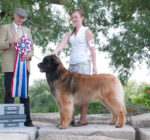LPN1 Genetic Test Result Interpretation
Clear (LPN1-N/N): A clear dog has no copies of the LPN1 gene mutation (this is also referred to as being
homozygous normal). However, this result does not rule out the possibility that a dog could have, or be a carrier
for, a different polyneuropathy mutation (including LPN2) that this test cannot detect. A LPN1 clear dog cannot
produce a LPN1-D/D dog.
Carrier/At Risk (LPN1-D/N): A carrier/at risk dog has one copy of the LPN1 gene mutation (this is also
referred to as being heterozygous). Having one copy of the mutated form of the LPN1 gene does not rule out the
possibility that a dog may have a polyneuropathy caused by the LPN1 mutation or another mutation not
detected by this test (including LPN2). LPN1 carriers will, on average, pass the LPN1 gene mutation on to half
of their offspring.
Affected (LPN1-D/D): An affected dog has two copies of the LPN1 gene mutation (this is also referred to as
being homozygous affected). Affected dogs typically develop neurological disease at or before 3 years of age
(average 1.9 years of age), and clinical signs tend to be severe, often requiring surgical intervention of laryngeal
paralysis. Affected dogs will pass one copy of this mutation on to all of their offspring.
LPN2 Genetic Test Result Interpretation
Clear (LPN2-N/N): A clear dog has no copies of the LPN2 gene mutation (this is also referred to as being
homozygous normal). However, this result does not rule out the possibility that a dog could have, or be a carrier
for, a different polyneuropathy mutation (including LPN1) that this test cannot detect.
Heterozygous Affected/Susceptible (LPN2–D/N): A heterozygous affected/susceptible dog has one copy of
LPN2 gene mutation. The average age that owners first notice clinical signs of PN in heterozygous affected
dogs, if they develop at all, is 6 years. On average, heterozygous affected dogs will pass along the LPN2
mutation to half of their offspring, this half will be LPN2 affected/susceptible.
Homozygous Affected/Susceptible (LPN2–D/D): A homozygous affected/susceptible dog has two copies of
the LPN2 gene mutation. In a limited number of homozygous affected dogs, the average age of onset is 4.5
years. Affected dogs will pass one copy of this mutation on to all of their offspring, and all will be LPN2
affected/susceptible.
LEMP Genetic Test Result Interpretation
Clear (LEMP-N/N): A clear dog has no copies of the LEMP mutation (this is also referred to as being
homozygous normal or free of the known mutation causing leukoencephalomyelopathy). A clear dog cannot
produce LEMP affected (D/D) offspring.
Carrier (LEMP-D/N): A carrier dog has one copy of the LEMP gene mutation (this is also referred to as
being heterozygous). A carrier dog is a healthy dog, and is not at risk of developing LEMP. LEMP carriers
will, on average, pass the LEMP gene mutation on to half of their offspring; they can produce LEMP-D/D
(affected/susceptible) offspring if mated to another carrier or affected dog.
Affected/Susceptible (LEMP-D/D): An affected/susceptible dog has two copies of the LEMP gene mutation
(this is also referred to as being homozygous affected). LEMP-D/D dogs often develop
leukoencephalomyelopathy at or before 3 years of age and clinical signs are characterized by slowly worsening
gait abnormalities, especially spontaneous knuckling, dragging of the paws and hypermetria of the thoracic
limbs, and a characteristic pattern on magnetic resonance imaging (MRI). Affected dogs show corresponding
gross lesions in the cervical spinal cord white matter that may extend to the thoracic spinal cord, as well as to
the brain; peripheral nerve and muscle biopsies are unremarkable. Spinal reflexes of affected dogs are mostly
normal. In the progressive clinical course of the disease, affected dogs may become increasingly immobile
within a few months. Like many diseases of the CNS, there is no effective treatment for LEMP. Since in most
cases the dog is not in pain, but is strongly restricted in its quality of life, owners are encouraged to ask a
veterinarian for advice. LEMP-D/D dogs will pass one copy of this mutation on to all of their offspring.
